The decoy ploy to save Scotland's elusive capercaillie
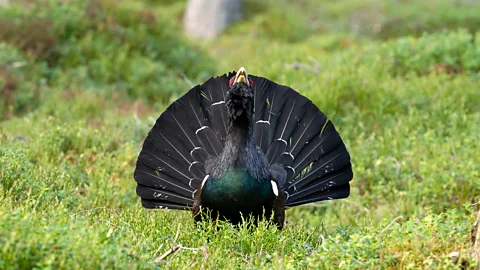 Cairngorms Capercaillie Project
Cairngorms Capercaillie ProjectIn Scotland, an unusual new plan is being used to tempt predators away from the eggs and chicks of the critically endangered capercaillie. Will it be enough to save this magnificent bird?
In the depths of the old Scots pine trees of Abernethy Forest, researcher and conservationist Jack Bamber has just dumped a pile of deer meat in the hope of attracting every nearby predator in a half-kilometre (0.3-mile) radius.
It may sound ominous, but it's all part of plan to divert predators who might otherwise be interested in lunching on a capercaillie chick.
Capercaillie are the world's largest grouse, famed for the males' beautiful fan tails and "leks" – gatherings of males who put on a show for females during the breeding season. They're also extremely secretive and have a notorious hatred of disturbance.
"You're almost surprised that you still have them in the UK, because it's not the kind of species that you anticipate to associate with the relatively boring species of Britain," says Bamber. "They're so big and so unique in the colouration, [with] their big, massive fan tails."
Conservationists have been pursuing efforts to help the capercaillie in Scotland for decades, but efforts have continued to fall flat and the species is now in deep trouble in this part of the world. At the last count in 2021-2022, just over 500 of the birds remained here, putting them on the brink of extinction. "Capercaillie are struggling, there's no denial of that," says Bamber.
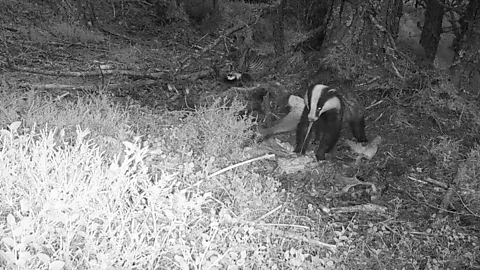 Jack Bamber
Jack BamberBamber's experiment is part of a conservation tactic known as diversionary feeding. The idea is simple: divvy out hunks of meat in areas where capercaillie are known to live, at strategic times of the breeding season when the young are most vulnerable. Hopefully, predators that would usually target ground-based nests or young chicks on the forest floor will instead head for the easier meal.
It's a way of decreasing predation on capercaillies without killing the predators themselves, says Bamber, who is pursuing a PhD on the topic at the University of Aberdeen. In Scotland this is especially pertinent, as two of the capercaillies' main predators, pine marten and badger, are themselves protected species.
The tactic has shown promise so far. But it's just one of several new and sometimes surprising conservation measures being used in Scotland to try to bring the capercaillie back from the brink.
When I visit Abernethy in mid-September, Carolyn Robertson and I spend the day studiously avoiding capercaillies.
In fact, helping people – and their dogs – avoid capercaillies is more or less Robertson's job description. As project manager for the Cairngorms Capercaillie Project, she has been leading a charge to inform people about how they may be inadvertently disrupting the birds.
I meet Robertson in the car park of the Loch Garten Nature Reserve, Abernethy, a tract of Caledonian pine forest owned by the Royal Society for the Protection of Birds (RSPB), one of a patchwork of landowners in the Cairngorms National Park.
Robertson has brought her dog, Mac, a huge, luscious brown flat-coated retriever who she keeps under control using a rope lead, gentle commands, a whistle and a pungent bum bag of sprats from which she occasionally feeds him.
We take a walk along the most used path of the nature reserve, to avoid the less-used parts where she says capercaillie are more likely to be. "Even if your dog is, as Mac is, on a lead, the very fact that he's here with us increases the likelihood of the capercaillie feeling threatened," says Robertson. Off the lead, dogs have been shown to flush out ground nesting birds with worryingly high rates.
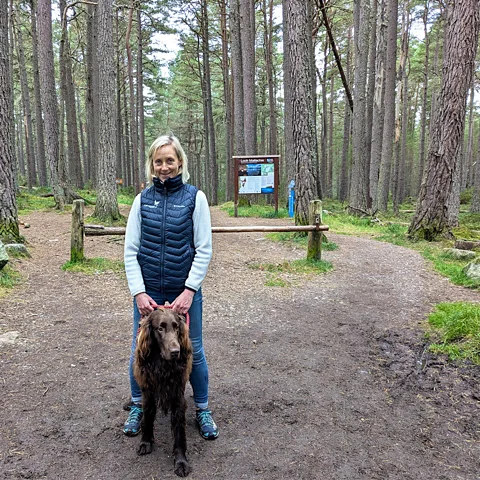 Jocelyn Timperley/ BBC
Jocelyn Timperley/ BBCDogs are a common sight here: alongside resident dogs, the region has around 6,000 resident dogs and sees an estimated 150,000 visiting dogs per year. Robertson says an information campaign with resident dog walkers in the nearby Boat of Garten area has seen good results, with capercaillie now seen lekking for longer.
"The local dog walkers [now] feel that it's their responsibility to look after the capercaillies," she says. The hope is that residents will set the tone for visitors, who are less likely to have heard of a capercaillie, let alone understand the impact their dogs might have on them.
Many people use these woodlands for recreational purposes, and Scotland's right to roam gives them the right to, so long as they act responsibly. But people themselves also disrupt capercaillie. A 2011 study in Germany and Switzerland found higher stress hormone levels in capercaillie droppings found closer to tourism locations. Studies have found they will avoid woodland tracks by up to 120m (390ft), and thus may be avoiding up to 40% of the available Scottish habitat. "That's kind of how strongly they don't want to be anywhere near us," says Robertson.
Working out the best situation for capercaillie to thrive isn't easy, however. Robert Moss, a retired ecologist who previously worked for the UK Centre for Ecology and Hydrology and has researched capercaillie for decades, says there could be an optimal amount of disturbance from people which scares off predators while leaving capercaillie relatively unaffected, sometimes known as the "human shield" effect.
The lichen-covered old Scots pine woodland Robertson and I are walking through is actually ideal capercaillie habitat: it's full of blaeberry (European blueberry) and young pine needles, which the birds feed on, and heather, which provides them cover. But Robertson views this path as somewhat of a sacrifice zone: her project encourages walkers to keep to paths like the one we are on, discouraging them from going elsewhere.
Mountain bikers, whose trails can pass through capercaillie habitat have been especially open to helping capercaillie, she says, such as by rerouting trails, putting up signs and avoiding early morning rides.
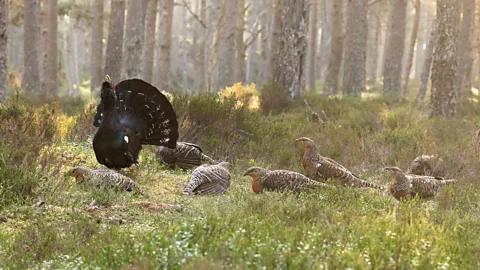 Cairngorms Capercaillie Project
Cairngorms Capercaillie ProjectMore difficult to contend with is some nature enthusiasts' desire to see or photograph a capercaillie, particularly while they are lekking.
Leks involve males gathering together on the forest floor in spring to strut around for hours, fanning their magnificent tails, sounding an array of pops, clicks and whistles, and fighting each other, while the far smaller females scrutinise them from the treetops.
A single photographer chasing a shot of a lek can end up disturbing and even disbanding it for good, says Robertson, adding that leks can otherwise remain in the same place for decades. When Robertson sees photos of capercaillie taken without a licence, she says, she just feels sadness for what are probably very stressed birds.
It's illegal in Scotland to disturb capercaillie without a licence when they are breeding. A seldom-granted licence from NatureScot, Scotland's wildlife agency is needed to visit nests or leks and requires strong mitigating measures. The Cairngorms Capercaillie Project's "Lek it be" campaign urges people to leave capercaillie in peace over the springtime. It has seen an especially positive response from the birding community, says Robertson.
Every capercaillie matters, because at the last count in 2021-2022 only an estimated 532 of them remained in Scotland, a 52% drop since the survey in 2015-2016.
This is not the first time the situation has been desperate for capercaillie in the UK. Their status as a popular game bird led numbers to plummet, possibly to extinction, in the late 1700s. They were reintroduced from Sweden 50 years later, however: the only successful reintroduction of a grouse species anywhere in the world. By 1970 some 20,000 birds were thought to live across Scotland, but this fell to 2,000 birds in the early '90s. Even as conservation efforts have since risen, capercaillie numbers have continued to fall.
 Cairngorms Capercaillie Project
Cairngorms Capercaillie Project"The species has definitely declined alarmingly over the last couple of decades, and it will take a lot of work to stop it going extinct," says Neil Metcalfe, a professor of behavioural ecology at the University of Glasgow who chaired a scientific subcommittee which wrote a 2022 review of capercaillie conservation.
One major cause has been the proliferation of deer fences over the late 20th Century. A 2001 study by Moss found young birds suffer heavy mortality from flying into unseen wires, especially forest fences. Removing and marking fences has now been a long running intervention.
Capercaillies, huge, turkey-sized birds with wingspans of up to 1.25m (4.1ft), also need a lot of space, which is challenging in the Scottish Highlands, where patches of forest are surrounded by agricultural land. Just 1% of Scotland's original Caledonian Scots pine forests, where capercaillie thrive, remain.
The Cairngorms National Park, which includes Abernethy Forest, aims for 50% of its entire area to be managed principally for ecosystem restoration by 2045. Some areas in particular are working to expand Scots pine forests, including by a deer management project which sells venison (the national park has high numbers of deer, which nibble at young pine saplings, hindering their growth).
It is also working to restructure Scots pine plantations to better support capercaillie and restore forest bogs, which should be improving the hens' spring diet and that of young chicks, says Moss.
Woodland expansion offers benefits to many other species, as well as carbon uptake. It is part of an effort to move from a species-specific approach to ecosystem restoration to deliver benefits for multiple species, says Robertson. But forest expansion takes decades to provide a suitable habitat for capercaillies, which now need emergency measures to survive in Scotland.
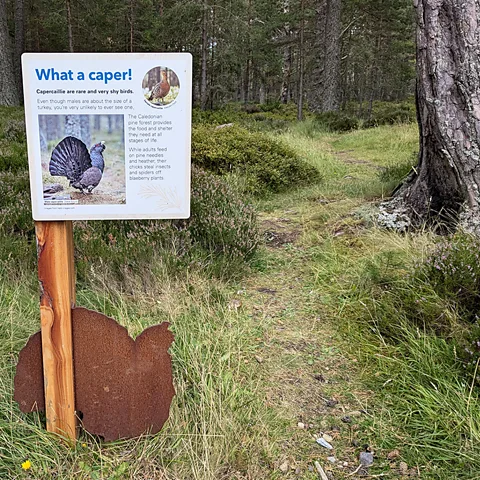 Jocelyn Timperley/BBC
Jocelyn Timperley/BBCInto this mix of measures has come Bamber's work on diversionary feeding using decoy deer meat. While culls of crows and foxes have previously been shown to help capercaillie, Bamber is looking at how to control predators, including protected badger and pine marten, non-lethally.
For his first study, published in 2024, he set up artificial capercaillie nests (using chicken eggs) across 60 sites of 1 sq km (0.4 sq miles) each, including in Abernethy Forest. In 30 of these sites, he stocked a central feeding station with deer meat over eight weeks in springtime. At the other 30 sites, no meat was put out. He also set up camera traps to watch what happened with the artificial nests.
Bamber used a waterproof kayaking sack to make it easier to carry the 10-15kg (22-33lb) of meat he would haul to each feeding station. "The smell was probably the worst part," he says. He'd also worry about coming across hikers who would think he was a murderer and flee the other way, he adds. "But thankfully, that never happened."
The work paid off: Bamber's research found that the areas with feeding stations saw 83% lower predation of the artificial capercaillie nests compared with areas where no meat was put down. "[The camera traps showed] pine marten were eating a lot of nests," says Bamber. "But we saw this massive reduction in the number of nests that they were consuming when we provided diversionary feeding."
(In Bamber's next study, published in June 2025 after this article was initially published, he looked at sightings of capercaillie chicks in camera traps as a measure of whether diversionary feeding is working. It showed the experiment had successfully doubled capercaillie brood numbers in the targeted areas.)
It will be several years before the impact of diversionary feeding on the overall population becomes clear. "There's no silver bullet for saving capercaillie in Scotland, I don't think," says Bamber. "We may not save the species with reducing predation alone, but we may give them a bit more of a chance, kick the can along the road when we hopefully improve habitat [and] connectivity."
Metcalfe says the experimental trials so far are encouraging. "It needs to be done carefully… so that it does not lead to an increase in the numbers of predators – but I think that it can work," he says.
Boosting predator numbers is an obvious concern here, but Bamber says the short timeframe food is put out – and the season, when lots of other food is available – reduces the likelihood of that.
More land managers in the area are now starting to give diversionary feeding a go, says Robertson. "There's a sense that there's nothing to lose by doing it," she says. Anecdotal sightings of females with more chicks than usual late in the breeding season is promising, she says, though "time will tell whether or not it enables a population recovery".
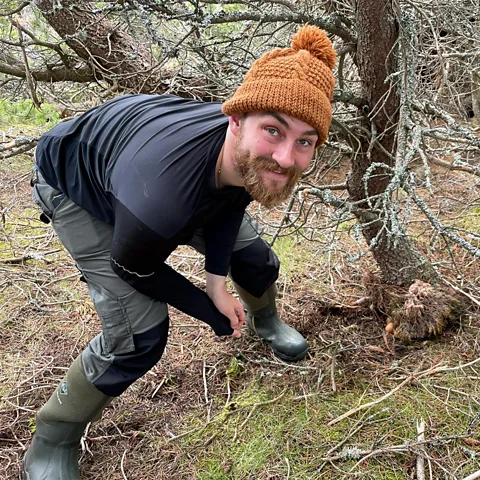 Jack Bamber
Jack BamberAssessing the impact of these interventions so far is tricky. Every year, the RSPB does a "lek count" around Scotland. This year's survey found 153 displaying males in leks,15 fewer than in 2023, sparking concern.
However, lek numbers tend to give only a rough idea of how the population is faring and tend to fluctuate from year to year. They have remained at roughly similar levels since 2021.
The real impact of newer interventions such as reducing recreational disturbance and diversionary feeding will become clearer when the next population survey arrives, scheduled for 2026. "Anecdotally on sites they're talking about seeing more broods, bigger broods, more young birds, that kind of indicator," says Robertson. "I genuinely would be surprised if we've gone down in the last five years."
Overhanging all these efforts, though, is another steadily encroaching change: climate change.
Research shows changes in climate have affected vegetation growth in spring, leading hens to be in poorer condition and so lay poorer quality eggs that hatch into less viable chicks, says Moss.
Wet springs are also difficult for capercaillie chicks, which can get cold and soggy and unable to dry off, says Robertson. "Essentially, chicks are dying of hypothermia." Colder, wetter springs also reduce the moth larvae insects chicks feed off, says Bamber.
Providing more bare ground and cover to help birds dry off and reducing stresses from other factors could help, says Robertson. But there's only so much that can be done. "The one big thing that will always impact [the population] is weather," she says. "We can be working our socks off, but if it's cold and wet, and chicks can't make it, then game over."
Research has also recently found a low genetic diversity in the Scottish capercaillie population. Along with the low numbers, this has led to early plans to reinforce the population with imported birds, including in a recent capercaillie "emergency" plan, delivered after a request from the Scottish government.
This is the "most comprehensive plan of its kind ever produced for this iconic bird", Eileen Stuart, NatureScot's deputy director of nature and climate change, told the press when the plan was launched in late September 2024. It includes plans to expand diversionary feeding and programmes to reduce disturbance, remove more fences and restore more woodland and bogs.
Metcalfe says he feels "heartened" by the plan, which will put "significant resources into a range of measures to protect the species".
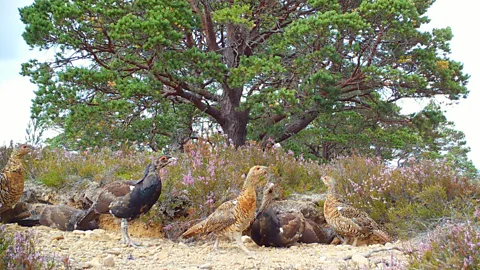 Jack Bamber
Jack BamberCapercaillie may be on their last legs in Scotland, as well as in some other areas such as the French Pyrénées and the Spanish Cantabrian mountains. But elsewhere the situation is not so bad. There are significantly larger populations of capercaillie in Scandinavia and Russia, for example, where woodland cover is far higher than in Scotland. With the situation so desperate for so long for capercaillies in Scotland, are the conservation efforts worth it?
"For sure it's an iconic, amazing species and I just feel like there's that slippery slope, if we lose it, it's just another one that we've lost," says Robertson. "It's not unusual when you've got a really vulnerable species that you fix one issue and then another represents itself, and it's just a constant conservation challenge." Many of the interventions to support capercaillies, she adds, help other species too.
Carbon Count
The emissions from travel it took to report this story were 40kg CO2. The digital emissions from this story are an estimated 1.2g to 3.6g CO2 per page view. Find out more about how we calculated this figure here.
Back when Bamber was first studying zoology at university, he never expected to be doing a conservation project consisting of "roaming around the woods with a load of deer on my back", he says. "But here we are. It's still just as important, it still makes a big difference to species. So it's worth it in the end. They're amazing, amazing birds."
Despite being "very close" to extinction in Scotland, the capercaillie remains a "symbol of hope" here, says Moss.
"It is also a magnificent sight," he adds. "A single sighting can provide ordinary people with a cherished memory that enriches their lives forever."
*Jocelyn Timperley is a senior journalist for BBC Future. Find her on Twitter @jloistf
**This article was updated on 25 June 2025 with the results of a new study by Jack Bamber and his colleagues on the impact of diversionary feeding on capercaillie brood numbers.
--
For essential climate news and hopeful developments to your inbox, sign up to the Future Earth newsletter, while The Essential List delivers a handpicked selection of features and insights twice a week.
